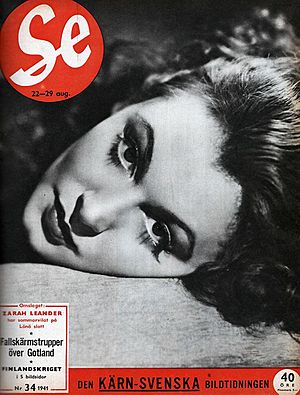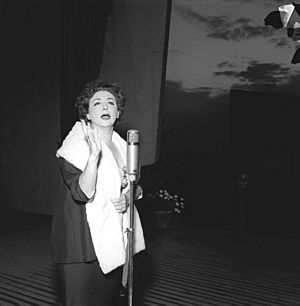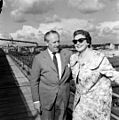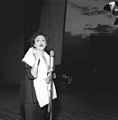Zarah Leander facts for kids
Quick facts for kids
Zarah Leander
|
|
|---|---|
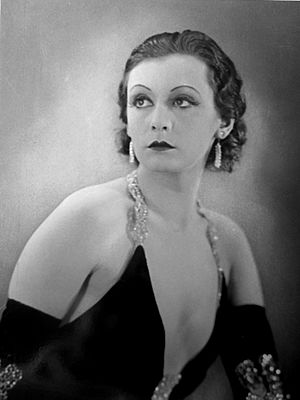
Leander in 1931
|
|
| Born |
Sara Stina Hedberg
15 March 1907 |
| Died | 23 June 1981 (aged 74) Stockholm, Sweden
|
| Occupation | Actress, singer |
| Years active | 1929–1979 |
| Spouse(s) |
|
| Children | 2 |
Zarah Leander (born Sara Stina Hedberg; 15 March 1907 – 23 June 1981) was a famous Swedish singer and actress. She became very successful in Germany between 1936 and 1943. During this time, she worked for a big state-owned film company called Universum Film AG (UFA). She was one of Europe's best-selling music artists before 1945.
Zarah Leander was known for her strong singing style and her deep, powerful voice. Her films and songs were sometimes seen as supporting the Nazi government at the time. Even though she never publicly supported the Nazis and was even called an "Enemy of Germany" by Joseph Goebbels (a powerful Nazi leader), she remained a debated person throughout her life.
Contents
Becoming a Star: Zarah Leander's Early Career
Zarah Leander was born Sara Stina Hedberg in Karlstad, Sweden. As a child, she learned to play the piano and violin. She first sang on stage when she was only six years old. For many years, she lived a normal life and did not plan to become a professional performer.
When she was a teenager, she lived in Riga, Latvia, from 1922 to 1924. There, she learned German and worked as a secretary. She married Nils Leander in 1926 and had two children.
In 1929, she got her first big chance. She was hired as an amateur singer for a touring cabaret show by Ernst Rolf. This is where she first sang "Vill ni se en stjärna" ("Do You Want to See a Star?"), which became her most famous song.
Big Breaks and International Dreams
In 1930, Zarah performed in four cabaret shows in Stockholm, the capital of Sweden. She also made her first music recordings, including a version of Marlene Dietrich's "Falling in Love Again". She even played a part in a film.
However, her biggest breakthrough came in 1931. She played "Hanna Glavari" in the famous operetta The Merry Widow by Franz Lehár. By this time, she had divorced Nils Leander. Over the next few years, she became a well-known artist in Scandinavia, performing on stage and in films. Her fame led to offers from other parts of Europe and from Hollywood. Many Swedish actors and directors were already working in Hollywood.
In the early 1930s, Zarah Leander worked with Karl Gerhard. He was a Swedish artist who strongly opposed the Nazis. In 1934, he wrote a song for Zarah called "I skuggan av en stövel" ("In the shadow of a boot"). This song openly criticized how Jews were treated in Nazi Germany.
Zarah decided to pursue an international career in Europe. She had two school-age children and did not want to move them far away to America. Europe, especially Austria and Germany, was much closer to home. Plus, she already spoke German well.
Her international debut was in 1936 in Vienna, Austria. She starred in a play called Axel an der Himmelstür (Axel at the Gate of Heaven). This play made fun of Hollywood movies and even Marlene Dietrich. After this, she starred in an Austrian film called Premiere, where she played a successful cabaret singer.
Zarah Leander: A Star for UFA Films
In 1936, Zarah Leander signed a contract with UFA in Berlin. UFA was a very important film studio in Germany at that time. Zarah was known for being a very tough negotiator. She demanded a lot of control over her work and a high salary. She even insisted that half of her pay be sent to a bank in Stockholm in Swedish money.
Even though Joseph Goebbels, the Nazi Propaganda Minister, called her an "Enemy of Germany" because of her demands, she became a leading film star at UFA. She starred in ten films, and most of them were huge successes. Zarah Leander did not spend time with important Nazi party members. She also did not take part in official Nazi Party events.
There's a famous story, which might not be true, about a meeting with Goebbels. He supposedly asked her, "Zarah... Isn't that a Jewish name?" She reportedly replied, "Oh, maybe, but what about Josef?" Goebbels then said, "Hmmm... yes, yes, a good answer."
Even with her connection to the Nazi film industry, she recorded a Yiddish song called "Bei Mir Bistu Shein" in 1938. In her films, Zarah Leander often played strong, beautiful, and confident women. She sang two of her biggest hit songs, "Davon geht die Welt nicht unter" ("This is not the end of the world") and "Ich weiss, es wird einmal ein Wunder geschehen" ("I know that someday a miracle will happen"). These songs, with her deep voice, gave people hope. Today, these songs are sometimes shown in documentaries as examples of how the Nazis used music to influence people.
We don't have exact numbers, but Zarah Leander was likely one of Europe's best-selling music artists before 1945. She later said that she earned most of her money not from her salary at UFA, but from the sales of her music records.
Returning Home: Zarah Leander in Sweden
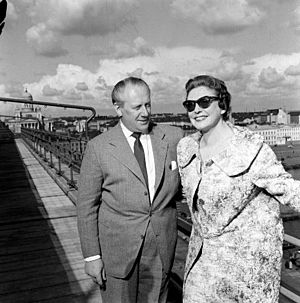
Zarah Leander's last film in Nazi Germany was released on March 3, 1943. Her home in Grunewald was damaged in an air raid. The Nazis, who were becoming more desperate, pressured her to become a German citizen. At this point, she decided to move back to Sweden. She bought a large house at Lönö, near Stockholm.
She still had a contract for another film with UFA, but she avoided making it by rejecting every script they sent her. Slowly, she started getting acting jobs on the Swedish stage. After World War II, she returned to Germany and Austria. She gave concerts, recorded new music, and acted in musicals. Many people who remembered her from before the war were excited to see her perform again.
She appeared in some films and TV shows, but she never became as popular as she was before and during the early years of World War II. In 1981, after retiring from performing, she passed away in Stockholm due to complications from a stroke.
Zarah Leander's Lasting Legacy
Zarah Leander remained popular in Germany for many years after World War II. She was interviewed several times on German television before she died. In 1983, a New Wave singer named Nina Hagen, who admired Zarah Leander as a child, released a song called "Zarah." This song was based on Leander's famous song "Ich weiss, es wird einmal ein Wunder geschehen."
In 1987, two musicals about Zarah Leander were created in Sweden. In 2003, a bronze statue of Zarah Leander was placed in her hometown of Karlstad, near the Opera house where she first started her career. A museum dedicated to Zarah Leander is also open near her home outside Norrköping. Every year, a scholarship is given to a creative artist who follows in her tradition.
Film Roles: Zarah Leander's Movies
Zarah Leander starred in many films throughout her career. Here are some of them:
- Dante's Mysteries (1931)
- The False Millionaire (1931)
- The Marriage Game (1935)
- Premiere (1937, her first film in German)
- To New Shores (1937)
- La Habanera (1937)
- Heimat (1938)
- The Blue Fox (1938)
- The Life and Loves of Tschaikovsky (1939)
- Das Lied der Wüste (1939)
- Das Herz der Königin (1940)
- Der Weg ins Freie (1941)
- The Great Love (1942)
- Back Then (1943)
- Gabriela (1950)
- Cuba Cabana (1952)
- Ave Maria (1953)
- It Was Always So Nice With You (1954)
- The Blue Moth (1959)
- Das Blaue vom Himmel (1964, TV film)
- How I Learned to Love Women (1966)
Stage Performances: Operettas and Musicals
Zarah Leander also performed in many stage productions, including operettas and musicals:
- 1931: Franz Lehár: Die lustige Witwe
- 1936: Ralph Benatzky: Axel an der Himmelstür (as Gloria Mills)
- 1958: Ernst Nebhut, Peter Kreuder: Madame Scandaleuse (as Helene)
- 1960: Oscar Straus: Eine Frau, die weiß, was sie will (as Manon Cavallini)
- 1964: Karl Farkas, Peter Kreuder: Lady aus Paris (as Mrs. Erlynne)
- 1968: Peter Thomas, Ika Schafheitlin, Helmuth Gauer: Wodka für die Königin (as Königin Aureliana)
- 1975: Stephen Sondheim, Hugh Wheeler: Das Lächeln einer Sommernacht (as Madame Armfeldt)
Images for kids
See also
 In Spanish: Zarah Leander para niños
In Spanish: Zarah Leander para niños


